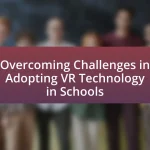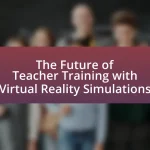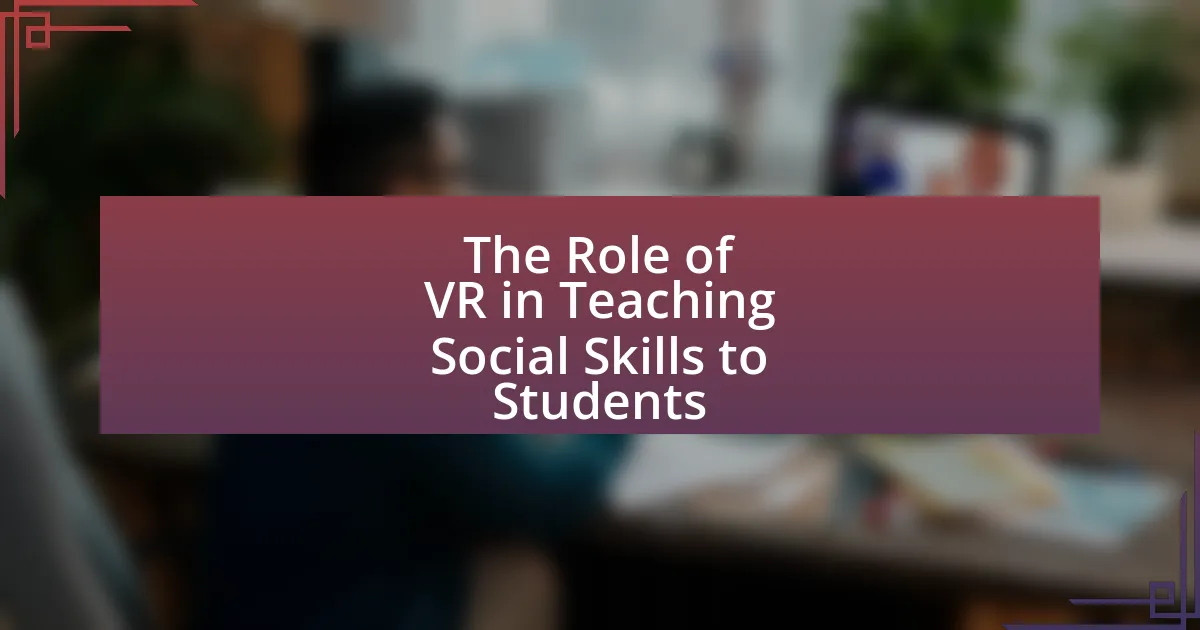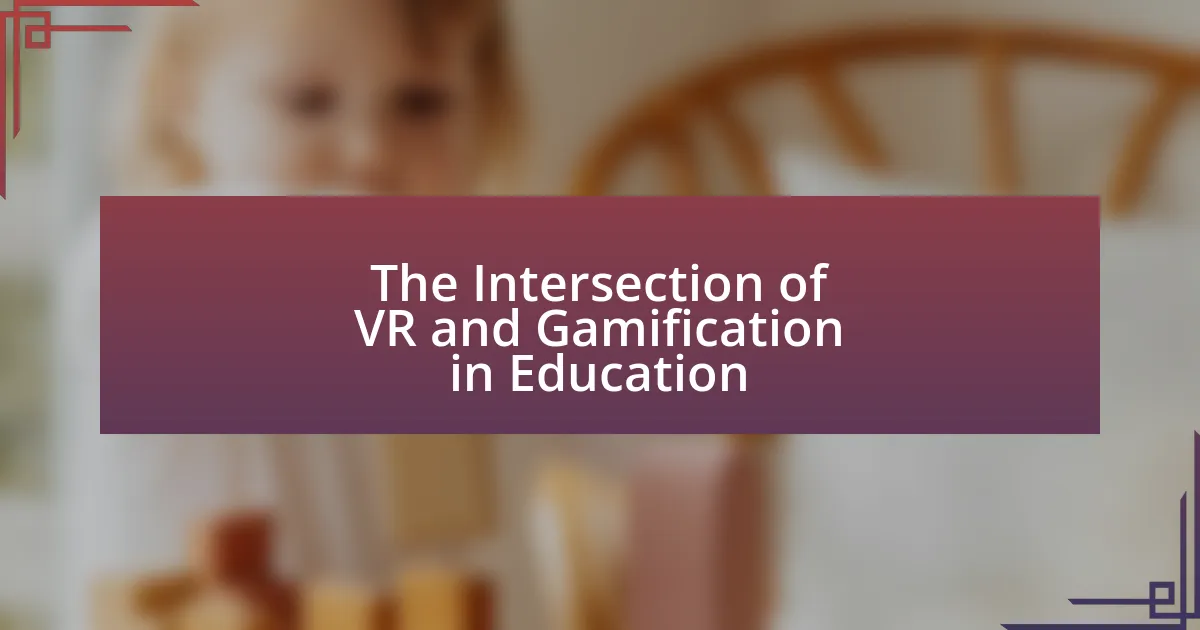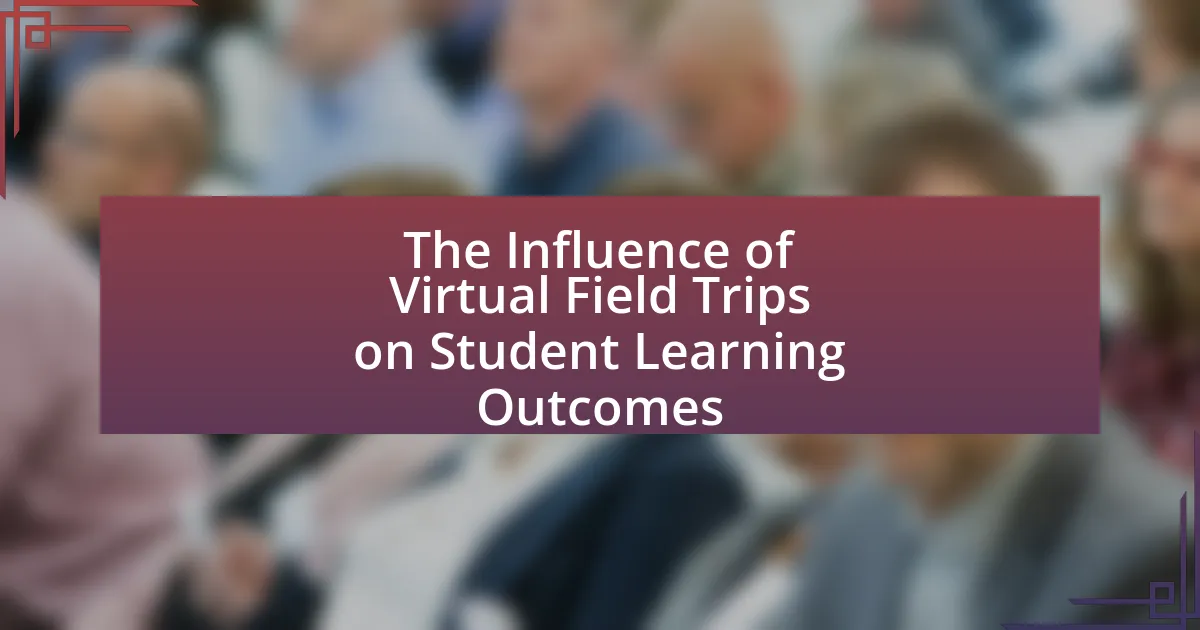The article examines the impact of Virtual Reality (VR) on student engagement in classrooms, highlighting how VR enhances learning through immersive and interactive experiences. It discusses research findings that indicate increased motivation, participation, and retention among students using VR compared to traditional teaching methods. Key features contributing to engagement include immersive environments, gamification, and personalized learning pathways. The article also addresses the importance of student engagement for academic success, the challenges educators face in integrating VR, and future developments in VR technology for education.
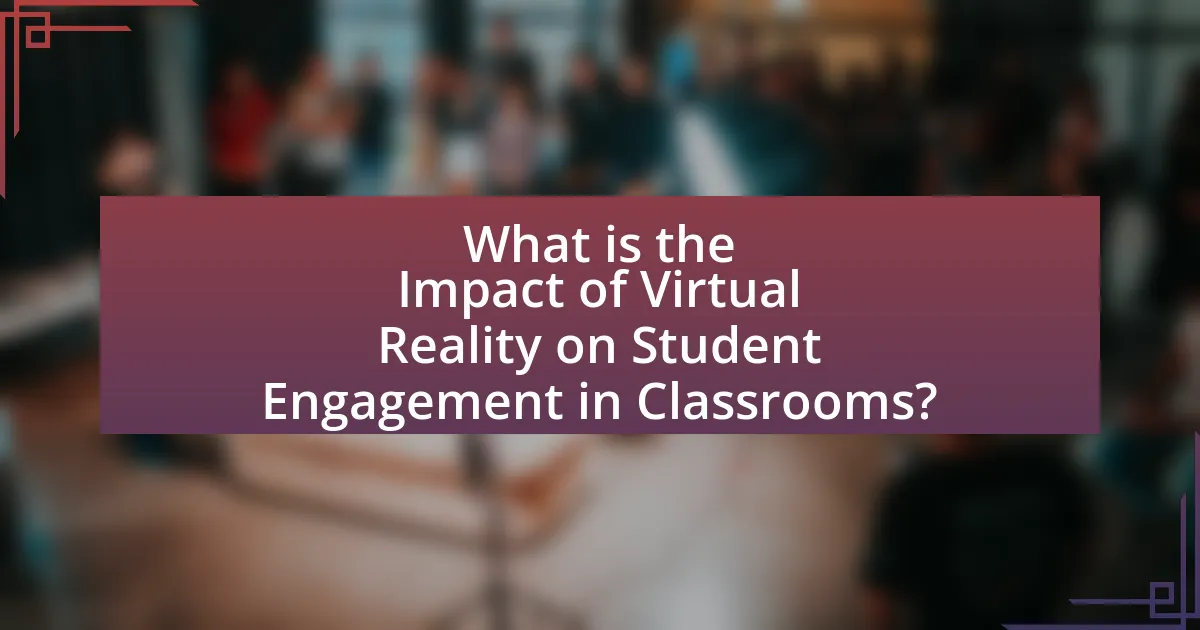
What is the Impact of Virtual Reality on Student Engagement in Classrooms?
Virtual Reality (VR) significantly enhances student engagement in classrooms by providing immersive and interactive learning experiences. Studies indicate that VR can increase student motivation and participation, as it allows learners to explore complex concepts in a simulated environment. For instance, research published in the journal “Computers & Education” by Mikropoulos and Natsis (2011) found that students using VR technology demonstrated higher levels of interest and retention of information compared to traditional teaching methods. This immersive approach fosters active learning, enabling students to visualize and interact with content, which leads to improved understanding and retention of material.
How does Virtual Reality enhance student engagement?
Virtual Reality enhances student engagement by providing immersive, interactive experiences that capture students’ attention and foster active participation. This technology allows learners to explore complex concepts in a simulated environment, making abstract ideas more tangible. Research indicates that students using Virtual Reality in educational settings demonstrate higher levels of motivation and retention; for instance, a study published in the Journal of Educational Technology & Society found that students engaged in VR-based learning scored 20% higher on assessments compared to traditional methods. This evidence supports the effectiveness of Virtual Reality in creating engaging learning experiences that improve educational outcomes.
What specific features of Virtual Reality contribute to increased engagement?
Immersive environments in Virtual Reality significantly contribute to increased engagement by providing users with a sense of presence and interactivity. The ability to explore 3D spaces and interact with virtual objects enhances cognitive involvement, making learning experiences more memorable. Research indicates that immersive simulations can lead to higher retention rates; for instance, a study by Mikropoulos and Natsis (2011) found that students using VR for learning scored 30% higher on retention tests compared to traditional methods. Additionally, the gamification elements often integrated into VR experiences, such as challenges and rewards, further motivate students to participate actively, fostering a deeper connection to the material.
How does immersion in Virtual Reality affect student focus and participation?
Immersion in Virtual Reality (VR) significantly enhances student focus and participation by creating an engaging and interactive learning environment. Research indicates that VR experiences can lead to increased attention spans, as students are more likely to be absorbed in the content when it is presented in an immersive format. For instance, a study by Mikropoulos and Natsis (2011) found that students using VR for educational purposes demonstrated higher levels of engagement and retention compared to traditional learning methods. This heightened engagement is attributed to the sensory stimulation and active involvement that VR provides, which can lead to improved participation in classroom activities.
Why is student engagement important in educational settings?
Student engagement is crucial in educational settings because it directly influences academic achievement and retention rates. Engaged students are more likely to participate actively in their learning, leading to deeper understanding and mastery of content. Research indicates that higher levels of student engagement correlate with improved performance; for instance, a study by Fredricks, Blumenfeld, and Paris (2004) found that engaged students demonstrate better grades and test scores. Additionally, engaged learners are more likely to persist through challenges, reducing dropout rates and fostering a positive learning environment.
What are the consequences of low student engagement?
Low student engagement leads to decreased academic performance and higher dropout rates. Research indicates that students who are not actively engaged in their learning are more likely to achieve lower grades and test scores, as evidenced by a study from the National Center for Education Statistics, which found that only 20% of students who reported low engagement graduated on time. Additionally, low engagement can result in a lack of motivation and interest in learning, further perpetuating a cycle of disengagement. This disengagement not only affects individual students but can also negatively impact classroom dynamics and overall school culture.
How does engagement influence learning outcomes and retention?
Engagement significantly enhances learning outcomes and retention by fostering deeper cognitive processing and emotional connections to the material. When students are actively engaged, they are more likely to participate in discussions, collaborate with peers, and apply concepts, which leads to improved understanding and memory retention. Research indicates that engaged learners demonstrate higher academic performance; for instance, a study published in the Journal of Educational Psychology found that students who reported high levels of engagement had test scores that were 20% higher than their less engaged peers. This correlation underscores the importance of engagement in facilitating effective learning experiences and long-term retention of knowledge.
What are the current trends in using Virtual Reality in classrooms?
Current trends in using Virtual Reality (VR) in classrooms include immersive learning experiences, enhanced engagement through gamification, and personalized education pathways. Immersive learning experiences allow students to explore complex subjects, such as anatomy or history, in a three-dimensional space, which has been shown to improve retention rates. For instance, a study by the University of Maryland found that students using VR for learning scored 30% higher on assessments compared to traditional methods. Enhanced engagement through gamification incorporates game-like elements into lessons, making learning more interactive and enjoyable. Additionally, personalized education pathways enabled by VR technology allow educators to tailor experiences to individual learning styles, fostering a more inclusive environment. These trends collectively demonstrate the growing integration of VR in educational settings to boost student engagement and learning outcomes.
Which subjects benefit most from Virtual Reality integration?
Subjects that benefit most from Virtual Reality integration include science, history, and mathematics. In science education, Virtual Reality allows students to conduct virtual experiments and explore complex concepts like molecular structures or astronomical phenomena, enhancing understanding and retention. In history, immersive experiences enable students to virtually visit historical sites or events, fostering a deeper connection to the material. Mathematics education benefits from VR by providing interactive visualizations of abstract concepts, making them more tangible and easier to grasp. Studies have shown that these subjects see increased engagement and improved learning outcomes when Virtual Reality is utilized, as evidenced by research conducted by the University of Maryland, which found that students using VR in science classes scored significantly higher on assessments compared to traditional teaching methods.
How are educators implementing Virtual Reality in their teaching practices?
Educators are implementing Virtual Reality (VR) in their teaching practices by integrating immersive experiences that enhance student engagement and understanding of complex subjects. For instance, VR allows students to explore historical sites, conduct virtual science experiments, or simulate real-world scenarios, which fosters active learning. Research from the University of Maryland found that students using VR for learning showed a 30% increase in retention rates compared to traditional methods. This evidence supports the effectiveness of VR in creating interactive and memorable educational experiences.
How does Virtual Reality compare to traditional teaching methods?
Virtual Reality (VR) enhances student engagement more effectively than traditional teaching methods. VR provides immersive experiences that allow students to interact with content in a three-dimensional space, leading to increased motivation and retention of information. Research by the University of Maryland found that students using VR scored 30% higher on assessments compared to those in traditional classrooms, demonstrating the effectiveness of VR in improving learning outcomes. Additionally, VR facilitates experiential learning, enabling students to practice skills in a safe environment, which traditional methods often lack.
What advantages does Virtual Reality offer over conventional classroom techniques?
Virtual Reality (VR) offers immersive learning experiences that enhance student engagement compared to conventional classroom techniques. VR allows students to interact with 3D environments, facilitating experiential learning that traditional methods cannot provide. For instance, a study by Mikropoulos and Natsis (2011) found that students using VR for science education demonstrated higher motivation and better retention of information than those in standard classrooms. This immersive quality of VR not only captures attention but also promotes active participation, leading to deeper understanding and improved academic performance.
What challenges do educators face when integrating Virtual Reality?
Educators face several challenges when integrating Virtual Reality (VR) into their teaching practices, including high costs, technical issues, and a lack of training. The high costs associated with VR hardware and software can limit access for many educational institutions, making it difficult to implement VR programs effectively. Technical issues, such as software compatibility and hardware malfunctions, can disrupt the learning experience and frustrate both educators and students. Additionally, many educators lack the necessary training to effectively incorporate VR into their curricula, which can hinder the successful integration of this technology. Research indicates that without proper support and resources, the potential benefits of VR in enhancing student engagement may not be fully realized.
What are the potential drawbacks of using Virtual Reality in classrooms?
The potential drawbacks of using Virtual Reality in classrooms include high costs, technical issues, and the risk of motion sickness among students. High costs arise from the need for specialized equipment and software, which can strain school budgets. Technical issues, such as software malfunctions or hardware failures, can disrupt learning experiences and frustrate both teachers and students. Additionally, some students may experience motion sickness or discomfort while using VR, which can hinder their ability to engage with the material effectively. These drawbacks highlight the challenges educators face when integrating Virtual Reality into classroom settings.
How can the cost of Virtual Reality technology impact its adoption?
The cost of Virtual Reality technology significantly impacts its adoption by limiting accessibility for educational institutions. High initial investments in hardware and software can deter schools from integrating VR into their curricula, as many educational budgets are constrained. For instance, a study by the International Society for Technology in Education found that the average cost of a VR headset can range from $300 to over $1,000, which is often prohibitive for underfunded schools. Consequently, this financial barrier can slow the widespread implementation of VR, hindering its potential to enhance student engagement in classrooms.
What are the concerns regarding accessibility for all students?
Concerns regarding accessibility for all students in the context of virtual reality (VR) in classrooms include the potential for unequal access to technology, physical disabilities that may hinder participation, and the need for inclusive content design. Unequal access arises because not all students have the same access to VR equipment or high-speed internet, which can create disparities in learning experiences. Additionally, students with physical disabilities may face challenges in using VR systems that are not designed with their needs in mind. Inclusive content design is crucial, as VR experiences must accommodate diverse learning styles and abilities to ensure that all students can engage effectively. These concerns highlight the necessity for educational institutions to prioritize accessibility in the implementation of VR technologies.
What future developments can we expect in Virtual Reality for education?
Future developments in Virtual Reality (VR) for education will likely include enhanced immersive experiences, improved accessibility, and integration with artificial intelligence. Enhanced immersive experiences will allow students to engage in realistic simulations, such as virtual field trips or historical reenactments, which can significantly increase engagement and retention of information. Improved accessibility will ensure that VR tools are available to a broader range of students, including those with disabilities, by incorporating adaptive technologies. Integration with artificial intelligence will personalize learning experiences, tailoring content to individual student needs and learning paces. These advancements are supported by ongoing research indicating that immersive learning environments can lead to higher levels of student motivation and achievement.
How might advancements in technology enhance Virtual Reality experiences?
Advancements in technology can significantly enhance Virtual Reality experiences by improving graphics, interactivity, and accessibility. Enhanced graphics, driven by developments in processing power and rendering techniques, create more realistic and immersive environments, which can lead to increased student engagement in educational settings. For instance, high-resolution displays and advanced graphics engines allow for lifelike simulations that can capture students’ attention more effectively than traditional methods. Additionally, improvements in haptic feedback technology enable users to feel sensations in the virtual environment, further deepening the immersive experience. Furthermore, advancements in wireless technology and mobile VR platforms make Virtual Reality more accessible to a broader audience, allowing students to engage with VR content anytime and anywhere, thus facilitating learning outside the classroom. These technological enhancements collectively contribute to a more engaging and effective Virtual Reality experience in educational contexts.
What role will Virtual Reality play in the evolution of classroom learning?
Virtual Reality (VR) will significantly enhance classroom learning by providing immersive and interactive experiences that engage students more deeply than traditional methods. VR allows learners to explore complex subjects, such as anatomy or historical events, in a three-dimensional space, fostering better understanding and retention of information. Research from the University of Maryland found that students using VR for learning scored 30% higher on assessments compared to those in conventional settings, demonstrating the effectiveness of VR in improving educational outcomes. This technology not only increases engagement but also caters to diverse learning styles, making education more accessible and effective for all students.
What best practices should educators follow when using Virtual Reality?
Educators should prioritize clear learning objectives when using Virtual Reality (VR) to enhance student engagement. Establishing specific goals ensures that VR experiences are aligned with curriculum standards and learning outcomes. Research indicates that when educators define objectives, such as improving spatial awareness or fostering empathy through immersive experiences, students demonstrate higher engagement levels and retention of information. For instance, a study by Mikropoulos and Natsis (2011) found that VR can significantly enhance learning outcomes when integrated with well-defined educational goals. Additionally, educators should provide adequate training for both themselves and students to navigate VR technology effectively, as familiarity with the tools can lead to more meaningful interactions and learning experiences.
How can teachers effectively integrate Virtual Reality into their lesson plans?
Teachers can effectively integrate Virtual Reality (VR) into their lesson plans by aligning VR experiences with curriculum objectives and utilizing immersive simulations to enhance learning. For instance, educators can use VR to create virtual field trips that allow students to explore historical sites or scientific environments, thereby making abstract concepts tangible. Research indicates that immersive learning environments can increase student engagement and retention; a study by Mikropoulos and Natsis (2011) found that students using VR showed improved understanding of complex subjects compared to traditional methods. By incorporating VR in a structured manner, teachers can foster interactive learning experiences that cater to diverse learning styles and promote deeper understanding of the material.
What strategies can be employed to assess student engagement with Virtual Reality?
To assess student engagement with Virtual Reality, educators can employ strategies such as observational assessments, surveys, and performance analytics. Observational assessments involve monitoring student interactions and behaviors during VR activities, providing insights into engagement levels. Surveys can be administered post-experience to gather student feedback on their engagement and interest, allowing for quantitative and qualitative analysis. Performance analytics can track student progress and participation metrics within the VR environment, offering concrete data on engagement trends. These strategies collectively provide a comprehensive understanding of how students interact with VR, supported by evidence from studies indicating that active participation correlates with higher engagement levels in immersive learning environments.

